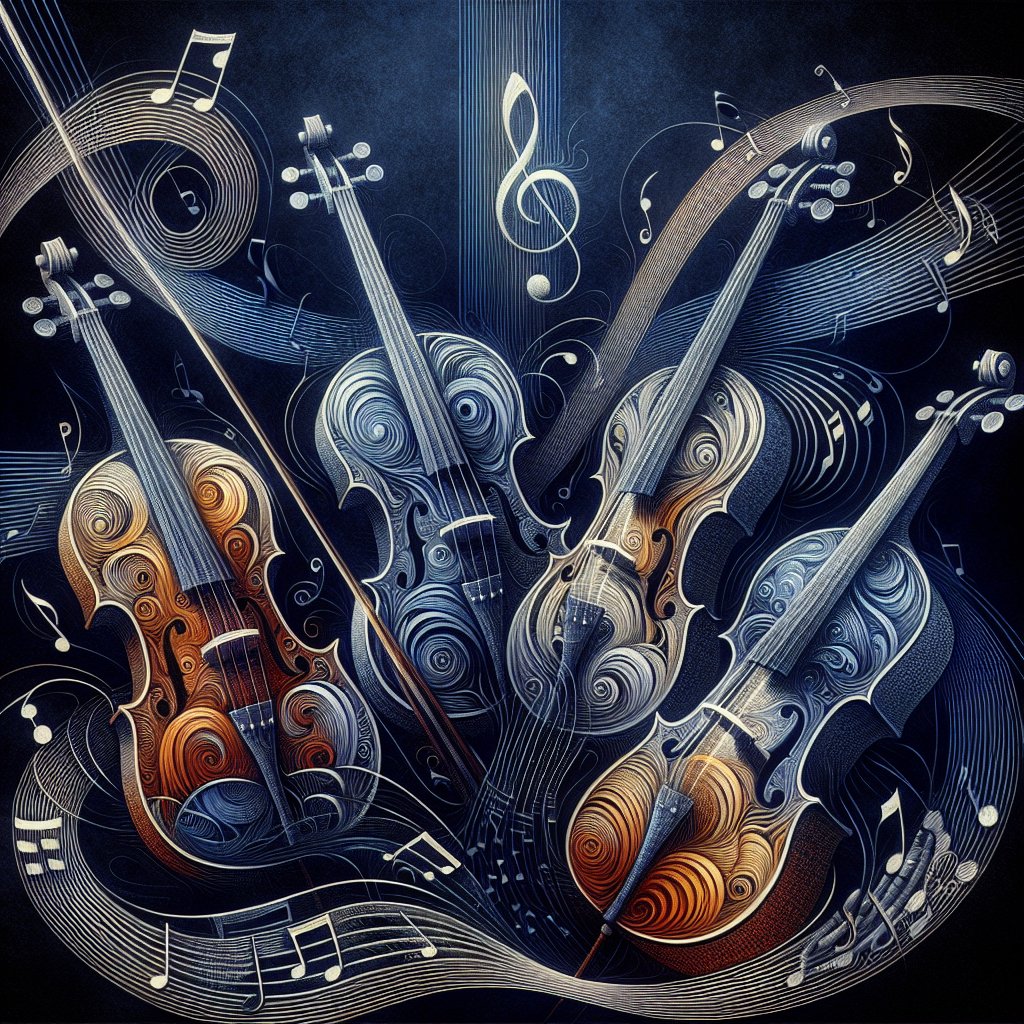
Beethoven’s String Quartet No. 14 – A Deep Dive
Ludwig van Beethoven, a towering figure in the history of Western music, composed a wealth of works that continue to be celebrated and analyzed to this day. Among his many contributions, his string quartets hold a special place as profound expressions of his artistic evolution. One of the most significant of these is his String Quartet No. 14 in C-sharp minor, Op. 131. Written in the final years of his life, this quartet is often considered one of Beethoven’s most ambitious and emotional works. In this article, we will delve deep into the history, structure, and impact of this monumental piece.
Beethoven’s String Quartet No. 14 is renowned for its complexity and depth, both musically and emotionally. Composed in 1826, it stands as a testament to Beethoven’s innovative approach to composition, breaking away from traditional forms and pushing the boundaries of what was considered possible in a string quartet. This seven-movement work, played without pause, showcases Beethoven’s mastery of form and his ability to convey profound human experiences through music. It is a piece that demands both technical proficiency and deep interpretative understanding from the performers, and offers listeners a rich and rewarding experience.
In order to fully appreciate the significance of this quartet, it is essential to understand the context in which it was composed. Beethoven was dealing with severe personal challenges during this period, including his increasing deafness and financial difficulties. Despite these struggles, he continued to compose some of his most forward-thinking and emotionally resonant works. The String Quartet No. 14 is a reflection of his inner turmoil and his unyielding artistic vision, making it a deeply personal and transcendent piece.
The Historical Context
The String Quartet No. 14 was composed during a particularly tumultuous period in Beethoven’s life. By the mid-1820s, his health was deteriorating, and he was completely deaf. Despite these hardships, Beethoven’s creative output did not wane. In fact, many of his late works are characterized by their profound depth and complexity, and the Op. 131 is no exception.
This period also saw Beethoven grappling with the dissolution of many friendships and a strained relationship with his nephew Karl, whom he had taken under his care. These personal difficulties had a profound impact on his music, infusing it with a sense of struggle and introspection. The String Quartet No. 14, composed in 1826, just one year before his death, is often seen as a culmination of these personal and artistic battles.
Beethoven’s late quartets, including the Op. 131, were initially met with confusion and skepticism by both critics and audiences. The unconventional structure and emotional intensity of these works were unlike anything that had been heard before. However, as time passed, the true genius of these compositions became apparent. Today, the String Quartet No. 14 is celebrated as one of Beethoven’s most extraordinary achievements, admired for its innovation and emotional depth.
The Structure of the Quartet
One of the most striking features of Beethoven’s String Quartet No. 14 is its structure. Unlike traditional quartets, which typically follow a four-movement format, the Op. 131 is composed of seven movements played without a break, creating a continuous and cohesive musical journey.
The first movement, Adagio ma non troppo e molto espressivo, sets the tone with its introspective and lyrical character. This is followed by the Allegro molto vivace, a lively and spirited movement that provides a stark contrast to the opening. The third movement, Allegro moderato, offers a moment of calm and reflection before the energetic Andante ma non troppo e molto cantabile of the fourth movement.
The fifth movement, Presto, is perhaps the most energetic and playful, showcasing Beethoven’s ability to infuse humor and lightness into his compositions. The penultimate movement, Adagio quasi un poco andante, returns to a more introspective and solemn mood, leading seamlessly into the final movement, Allegro. This concluding movement brings the quartet to a triumphant and impassioned close, encapsulating the emotional journey of the entire piece.
The seamless transition between movements creates a sense of unity and continuity, making the quartet feel like a single, expansive work rather than a series of separate movements. This innovative structure was highly unconventional for its time and is a testament to Beethoven’s forward-thinking approach to composition.

Musical Themes and Motifs
Throughout the String Quartet No. 14, Beethoven employs a variety of musical themes and motifs that recur in different forms across the movements. This technique of thematic transformation adds to the sense of cohesion and unity, as familiar themes are revisited and reinterpreted in new contexts.
The first movement introduces a hauntingly beautiful theme that reappears throughout the quartet in various guises. This theme is characterized by its expressive and lyrical quality, setting the emotional tone for the entire piece. In contrast, the second movement features a more energetic and rhythmic motif, providing a sense of drive and momentum.
The fourth movement’s theme, with its song-like quality, stands out as one of the most memorable in the quartet. Its lyrical and flowing character offers a moment of respite and reflection amidst the quartet’s more intense and energetic sections. The playful and whimsical theme of the fifth movement adds a touch of humor, showcasing Beethoven’s ability to balance profundity with lightheartedness.
By weaving these themes and motifs throughout the different movements, Beethoven creates a rich tapestry of musical ideas that guide the listener through the quartet’s emotional landscape. This technique not only enhances the overall coherence of the piece but also allows for a deeper exploration of the themes and emotions at play.
Technical Challenges for Performers
Beethoven’s String Quartet No. 14 is widely regarded as one of the most challenging works in the string quartet repertoire. Its technical demands require a high level of proficiency from each member of the ensemble, as well as a deep understanding of the piece’s emotional and structural nuances.
One of the primary challenges lies in the quartet’s continuous structure. With no breaks between movements, performers must maintain their focus and energy throughout the entire piece, ensuring smooth transitions and maintaining the musical flow. This requires not only technical skill but also stamina and concentration.
The quartet also features a wide range of dynamics and articulations, requiring precise control and versatility from the performers. From delicate, whispering passages to powerful, fortissimo sections, the musicians must navigate a vast emotional and dynamic landscape, bringing out the full expressive potential of the music.
Additionally, the interplay between the different instruments requires a high level of ensemble cohesion and communication. The intricate counterpoint and complex rhythms demand precise synchronization, as each musician’s part is interwoven with the others to create a cohesive whole. Achieving this level of ensemble unity is no small feat and requires a deep understanding of both the individual parts and the overall structure of the quartet.
Impact and Legacy
Since its composition, Beethoven’s String Quartet No. 14 has had a profound and lasting impact on the world of chamber music. Its innovative structure, emotional depth, and technical challenges have inspired countless performers and composers, cementing its place as one of the pinnacles of the quartet repertoire.
The quartet’s influence can be seen in the works of later composers, who drew inspiration from Beethoven’s innovative approach to form and thematic development. Composers such as Schubert, Brahms, and Bartók, among others, built upon the foundations laid by Beethoven, exploring new possibilities in the realm of chamber music.
In addition to its influence on composers, the String Quartet No. 14 has captivated audiences and performers alike with its profound emotional resonance. Its ability to convey a wide range of human experiences, from introspection and melancholy to joy and triumph, continues to resonate with listeners, making it a timeless and universal work.
Today, the Op. 131 is celebrated as one of Beethoven’s most extraordinary achievements, regularly performed by string quartets around the world. Its enduring popularity and continued influence are a testament to its greatness, ensuring that Beethoven’s legacy lives on through this remarkable piece.
Conclusion
Beethoven’s String Quartet No. 14 in C-sharp minor, Op. 131, stands as a monumental achievement in the world of chamber music. Composed during a period of personal and artistic turmoil, it is a deeply introspective and emotionally charged work that pushes the boundaries of traditional quartet form.
Its innovative structure, consisting of seven interconnected movements played without pause, creates a sense of unity and continuity that was highly unconventional for its time. Thematic transformation and the interplay of musical motifs further enhance the coherence and emotional depth of the piece, guiding listeners through a rich and varied musical journey.
The technical challenges of the quartet demand a high level of proficiency and insight from performers, requiring precise control, ensemble cohesion, and a deep understanding of the work’s emotional and structural nuances. Despite these challenges, the Op. 131 remains a beloved and frequently performed piece, celebrated for its profound impact and lasting legacy.
Through the exploration of themes, the mastery of form, and the expression of deep human emotions, Beethoven’s String Quartet No. 14 continues to inspire and move audiences and performers alike. It is a testament to Beethoven’s genius and his unyielding artistic vision, solidifying its place as one of the greatest works in the history of music.